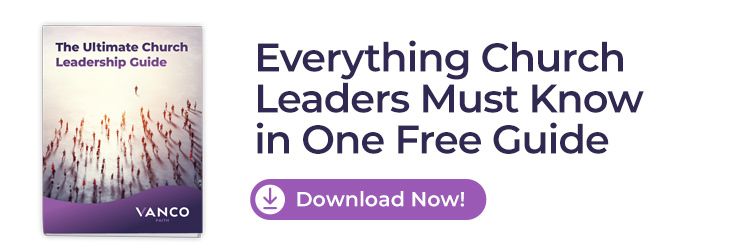
Why do prayer meetings often feel uninspiring? It’s not because people lack faith — it’s because the same predictable routines leave attendees disengaged. Whether it’s rigid formats, long monologues or limited participation, these common pitfalls drain the energy from gatherings meant to connect believers with God. The good news? With the right prayer meeting ideas, you can transform these sessions into moments of deep faith, connection and renewal.
Table of Contents
- Why Do Prayer Meetings Often Feel Boring?
- How Can We Inject Excitement into Our Prayer Time?
- What Are Some Interactive Prayer Meeting Ideas for Small Groups?
- How Can We Use Technology to Enhance Our Prayer Meetings?
- What Scripture-Based Activities Can Liven Up Prayer Meetings?
- How Can We Encourage Participation from All Group Members?
- What Final Thoughts Should We Consider for Revitalizing Prayer Meetings?
- FAQs
- The Free Guide Every Church's Group Leader Must Have
Too Busy to Read? Listen to the Key Takeaways
Get the key takeaways by clicking to listen the podcast summary now!
Why Do Prayer Meetings Often Feel Boring?
Common Pitfalls in Traditional Prayer Meetings
Prayer meetings are intended to be moments of spiritual awakening, renewal and community connection, but they often fall into predictable patterns. Many participants find these gatherings uninspiring due to routines that rarely change. For instance, a rigid structure — starting with a hymn, followed by a long monologue prayer and concluding with a few prayer requests — can make the experience feel formulaic. Overly long sessions may also test attention spans, leaving attendees disengaged. Another common issue is limited participation; when only a few voices dominate, others may feel disconnected or unimportant.
Both monologues and certain voices dominating the meeting can strain attention spans. One of the reasons why prayer meetings have fallen off in the past decades is because the old format just doesn't fit our modern world. If you're wondering why, consider this: according to The Treetop, the new average attention span is just 8.25 seconds. From the year 2000 to 2015, there was also a drop of 25% in attention span according to their data. And it isn't just Treetop reporting this. According to a discussion on the American Psychological Organization's Podcast with Dr. Gloria Mark, the fall is even more precipitous. Mark notes in a study she conducted that from 2004 to 2018, people's attention spans fell from 2.5 minutes to 47 seconds for a specific task they were given. That's a 60% drop.
The absence of variety in content and format further exacerbates these challenges. Without intentional planning, meetings can feel routine and lack the fresh perspectives and creativity needed to maintain interest. When participants know exactly what to expect, they may approach the gathering with less enthusiasm, viewing it as a duty rather than a meaningful encounter with God.
The Impact of Monotony on Spiritual Growth
Monotony in prayer meetings doesn’t just bore participants — it can also hinder their spiritual growth. Repetition without depth often leads to complacency, where attendees go through the motions without genuine engagement. When meetings fail to inspire, participants may lose focus, diminishing their ability to connect with God. Over time, this lack of enthusiasm can create a barrier to spiritual development, as attendees may no longer see prayer meetings as vital to their faith journeys.
For example, a predictable format may discourage participants from bringing their personal struggles or breakthroughs to the group. This stifles opportunities for communal encouragement and accountability. Ultimately, the disconnect between intention and experience can lead individuals to skip prayer meetings altogether, robbing them of the spiritual nourishment these gatherings are meant to provide.
Addressing the Need for Engaging Prayer Experiences
Creating engaging prayer meetings is essential to meaningful spiritual growth. Engaging gatherings not only draw participants closer to God but also strengthen the sense of community among attendees. Leaders must recognize that variety and intentionality are key to keeping participants invested.
Tailoring activities to suit the group’s dynamics can make a significant difference. For example, youth prayer meetings might benefit from interactive and fast-paced formats, while adult groups might find value in reflective and contemplative sessions. By integrating creative elements — such as thematic focuses, multimedia tools or artistic expressions — prayer meetings can become a source of inspiration rather than obligation.
As 24-7 Prayer International discovered, shifting to dynamic formats resulted in a dramatic increase in attendance, from 40 to 700 participants. This demonstrates that fresh approaches can breathe life into otherwise stagnant gatherings, ensuring groups help people and invite people to grow in the community.
How Can We Inject Excitement into Our Prayer Time?

Create a Theme for Each Prayer Meeting
Introducing themes to prayer meetings can provide focus and purpose, transforming them from routine gatherings into intentional and inspiring events. Themes such as “Prayers for Healing,” “Gratitude Night,” or “Praying for the Nations” can align participants’ hearts and minds toward a common goal. A well-chosen theme gives direction and structure to the meeting, ensuring that the time feels meaningful and relevant.
For instance, a “Gratitude Night” could start with participants sharing personal testimonies of answered prayers, followed by prayers of thanksgiving and worship. A theme like “Prayers for Healing” might involve specific prayer requests for those in need, paired with relevant scripture readings and moments of silent reflection. By varying themes regularly, attendees are more likely to look forward to each gathering, eager to explore new aspects of their faith.
Incorporate Various Prayer Styles and Formats
Another way to inject excitement into prayer meetings is by diversifying prayer styles and formats. Traditional formats often lean heavily on spoken prayers, but adding variety of prayers can make gatherings more dynamic and inclusive. Silent prayer, group intercession, guided meditation and praise-filled prayers each bring unique benefits to the spiritual experience.
For example, silent prayer can offer participants a chance to listen for God’s voice, while group intercession fosters unity as participants pray over shared concerns. Guided meditation, particularly when centered on a specific scripture, allows for deep spiritual reflection. Meanwhile, praise-filled prayers that incorporate worship songs can uplift the mood and foster a sense of collective joy.
Dynamic formats keep attendees engaged and provide opportunities for individuals with different prayer preferences to feel included. This inclusivity strengthens the group’s overall sense of community and purpose.
Use Creative Activities to Enhance Prayer Focus
Creative activities can help participants connect emotionally and spiritually during prayer meetings. For example, prayer journaling allows individuals to document their prayers and reflect on their spiritual journeys over time. Leaders can also encourage participants to write prayer cards — brief notes with prayer requests or words of encouragement — to be shared with the group.
Interactive storytelling is another powerful tool. Sharing personal stories of faith or answered prayers inspires others and makes the meeting feel deeply personal. Visual elements, like creating a prayer wall where participants can pin their prayer requests, can add a tangible and interactive layer to the meeting.
One church reported that implementing such creative approaches led to a significant increase in engagement, with 49% of teens expressing a willingness to attend prayer meetings. These activities offer a break from monotony and enable participants to experience prayer in new and meaningful ways.
What Are Some Interactive Prayer Meeting Ideas for Small Groups?
Prayer Stations: A Hands-On Approach to Communal Prayer
Prayer stations are an excellent way to make your prayer meetings interactive and meaningful. This approach involves setting up different stations, each focused on a specific prayer topic, such as forgiveness, gratitude or global needs. At each station, participants can engage in activities that align with the theme. For instance:
- A forgiveness station might include writing down personal burdens on a piece of paper and symbolically shredding them.
- A gratitude station could feature sticky notes where participants write things they’re thankful for and post them on a gratitude board.
- A station for global needs might display a world map where attendees can mark countries with specific prayer requests.
This hands-on format allows participants to move at their own pace, reflecting deeply on each topic. Prayer stations encourage individual engagement while fostering a sense of shared purpose. They are particularly effective in small group settings where intimacy and interaction are key.
Prayer Walks: Combining Physical Activity with Spiritual Reflection
Prayer walks are another interactive option, blending physical movement with focused prayer. These involve walking through a specific area — such as a neighborhood, park or church grounds — while praying for the needs and people associated with that space. Prayer walks can be organized around particular themes, such as:
- Praying for the community while walking through residential neighborhoods
- Reflecting on creation and offering praise during a nature walk
- Interceding for students and staff while walking through a school campus
To add structure, leaders can provide participants with prayer prompts or topics to focus on during the walk. For example, prompts might include praying with others for the well-being of those in the area, wisdom for leaders or healing for the sick. The combination of movement and prayer often helps participants feel more connected and present, enhancing their overall experience.
Artistic Prayer Expressions: Drawing, Painting and Crafting Prayers
For small groups looking to explore new ways of connecting with God, artistic prayer expressions can be a powerful tool. Creative outlets like drawing, painting and crafting offer participants an opportunity to express their prayers visually. Examples include:
- Drawing scenes from Scripture that resonate with personal experiences
- Painting abstract representations of emotions or prayer topics
- Crafting prayer beads or bracelets as a tangible reminder of God’s presence
These activities provide an alternative to verbal prayer, allowing participants to communicate with God and see how God speaks through their creativity. They can also be deeply meditative, helping individuals process emotions and connect with their faith on a deeper level.
Artistic prayer expressions are especially impactful for those who may hesitate to pray out loud. By focusing on their creative work, participants can engage in prayer in a way that feels personal and meaningful.
How Can We Use Technology to Enhance Our Prayer Meetings?
Virtual Prayer Rooms and Online Prayer Walls
In today’s digital age, technology can help expand the reach and accessibility of prayer meetings. Virtual prayer rooms and online prayer walls offer a platform for participants to connect, even if they are unable to attend in person. Platforms like Zoom or Microsoft Teams can host live prayer gatherings, where participants take turns sharing requests and praying together in real time. Breakout rooms can be used for smaller group sessions, fostering intimacy and focused prayer.
Online prayer walls allow participants to post prayer requests that the group can revisit and pray over. For example, a church might create a dedicated page on its website where members can write requests anonymously. Others can respond with messages of encouragement or simply commit to praying for those needs. These tools keep prayer meetings alive in virtual spaces and ensure that participants feel supported, no matter where they are.
If you're looking for more details on setting up a virtual prayer meeting, check out our free Virtual Prayer Meeting Guide.
Prayer Apps and Digital Resources
Prayer apps and digital tools can serve as valuable resources to enhance prayer meetings. Apps like PrayerMate, Echo Prayer and Inner Room offer features such as prayer request organization, reminders and guided prayer sessions. Leaders can use these tools to structure meetings or encourage participants to maintain their prayer habits throughout the week.
In addition to apps, digital devotionals and resources from websites like BibleGateway or YouVersion can enrich meetings. Leaders might incorporate guided prayer plans or suggest digital devotionals that align with each meeting’s theme. By leveraging these resources, meetings can be more organized, and participants can leave with tools to continue their spiritual growth independently
Multimedia Elements in Prayer Gatherings
Adding multimedia elements to prayer meetings can create a richer sensory experience, helping participants stay engaged and connected. For instance:
- Projecting Bible verses or inspirational quotes on a screen can set a reflective tone.
- Sharing worship videos or background music can enhance moments of praise and contemplation.
- Using slideshows with images or short video clips can guide participants through specific prayer topics, such as global missions or local community needs.
Multimedia can also be used for storytelling. For example, a short video about answered prayers or a testimony from a group member can inspire attendees and build faith. These elements provide a dynamic experience that appeals to various learning and engagement styles, making prayer meetings more inclusive and impactful.
What Scripture-Based Activities Can Liven Up Prayer Meetings?
Lectio Divina: Praying with Scripture
Lectio Divina, or "divine reading," is an ancient practice that helps participants engage deeply with Scripture through prayerful reflection. This method is ideal for group prayer meetings because it provides a structured yet contemplative way to connect with God’s Word. Here’s a step-by-step guide to practicing Lectio Divina:
- Read: Choose a passage of Scripture and read it slowly and aloud. Encourage participants to listen for a word or phrase that stands out to them.
- Meditate: Reread the passage, asking attendees to reflect on the chosen word or phrase. How does it relate to their current circumstances?
- Pray: Invite people to pray based on their reflections, expressing gratitude, questions or desires inspired by the text.
- Contemplate: Close with a time of silent reflection, allowing participants to rest in God’s presence and absorb the message.
By following Lectio Divina's process, you can transform Scripture into a living conversation with God.
Bible Verse Meditation and Application Exercises
Meditating on Bible verses can create a focused and enriching prayer experience. Leaders can select verses that align with the theme of the meeting, such as peace, healing or gratitude. During the session, participants can reflect on the meaning of the verse and consider its application in their lives.
Here’s how to structure this activity:
- Start by reading the verse aloud multiple times, pausing for silent reflection after each reading.
- Ask people open-ended questions like, “What does this verse reveal about God?” or “How does this verse encourage you in your current situation?”
- To conclude, pray as a group or have a discussion where attendees share their insights or prayer requests inspired by the verse.
Praying Through Psalms: A Guide for Emotional Expression
The Psalms are a rich resource for prayer, offering words for every emotion, from joy and gratitude to sorrow and lament. Using Psalms as templates for prayer can help participants articulate feelings they may struggle to express. For example:
- Use Psalm 23 for prayers of comfort and trust.
- Draw from Psalm 51 for prayers of repentance.
- Pray through Psalm 100 for gratitude and praise.
Leaders can guide participants in personalizing the Psalms by substituting their own situations or feelings into the text. For instance, instead of “The Lord is my shepherd; I shall not want,” a participant might pray, “The Lord is my guide; I will trust Him to provide for my needs.”
How Can We Encourage Participation from All Group Members?
Implement Prayer Partners and Small Breakout Groups
One effective way to foster participation is by organizing attendees into prayer partners or small breakout groups. These setups create a more intimate environment where participants feel comfortable sharing and praying aloud. For instance, pairing attendees as prayer partners encourages accountability and deepens relationships. Each partner can share specific needs and commit to praying for one another, both during the meeting and throughout the week.
Small breakout groups work well for larger gatherings, dividing participants into manageable units. Leaders can assign each group a specific prayer focus, such as family, community or global issues. This structure ensures that everyone has a chance to actively participate, reducing the pressure of speaking in front of a large group. Breakout groups also create a supportive atmosphere that fosters trust and openness.
Use Prayer Prompts and Conversation Starters
Sometimes, attendees hesitate to participate because they don’t know what to say. Prayer prompts and conversation starters can help ease this uncertainty, providing a clear direction for their prayers. For example:
- “What are you grateful for today?”
- “Who in your life needs prayer and how can we intercede for them?”
- “What challenges are you facing that we can lift up to God together?”
Leaders can also offer written prompts on cards or display them on a screen. These prompts serve as conversation starters, encouraging participants to reflect on their thoughts and share them with the group. By removing the pressure to come up with ideas for prayer on the spot, attendees are more likely to engage.
Create a Safe Space for Sharing and Vulnerability
Building trust is essential for encouraging participation. Attendees need to feel that their contributions are valued and that the group is a safe space for sharing. Leaders can establish this trust by setting ground rules, such as confidentiality and a commitment to non-judgment. For example, leaders might say, “What’s shared in this room stays in this room.”
Starting each meeting with an icebreaker or a brief devotional can also help create a welcoming atmosphere. Personal testimonies, either from the leader or volunteers, can inspire others to open up. When participants see others sharing vulnerably, they are more likely to follow suit.
Leaders should also be intentional about including quieter members. Simple actions, like asking for prayer requests or inviting them to lead a short prayer, can make a big difference. Over time, as attendees grow more comfortable, their willingness to participate will naturally increase.
What Final Thoughts Should We Consider for Revitalizing Prayer Meetings?
Balance Structure and Spontaneity in Prayer Gatherings
A well-balanced prayer meeting includes both structure and flexibility, ensuring it is both organized and Spirit-led. Planning a clear agenda helps participants know what to expect, while leaving room for spontaneity allows the Holy Spirit to guide the gathering in unexpected and meaningful ways. For example, a structured plan might include a welcome, a short devotional, group prayer time and a closing activity. Within this framework, leaders can encourage attendees to share spontaneous prayer requests or testimonies as the Spirit leads.
The key is to avoid rigidity while maintaining a sense of purpose. Leaders should remain sensitive to the group’s dynamics and ready to adapt if a particular prayer focus resonates deeply with participants. This balance fosters an environment where both preparation and divine intervention can thrive.
Nurture a Culture of Expectancy and Spiritual Growth
Creating a sense of expectancy is vital for a vibrant prayer meeting. When attendees come expecting to encounter God, their engagement and enthusiasm increase. Leaders can cultivate this mindset by emphasizing the power of prayer and sharing testimonies of answered prayers. For example, mentioning that 87% of praying Americans report experiencing answered prayers can build faith and inspire participants to pray with boldness.
Additionally, prayer meetings should nurture spiritual growth by challenging participants to deepen their relationship with God. Introducing scripture-based activities, new prayer methods or themes that stretch participants spiritually can make each gathering feel like a step forward in their faith journey.
Regularly Evaluate and Adapt Prayer Meeting Formats
To ensure prayer meetings remain engaging and impactful, leaders should regularly evaluate their effectiveness. Seeking feedback from participants is an excellent way to understand what is working and what could be improved. For instance, leaders might ask attendees questions like:
- “What aspects of the meeting did you find most meaningful?”
- “Are there any changes or additions you’d like to see in future gatherings?”
Leaders should also be proactive in assessing attendance trends, participation levels and the overall spiritual atmosphere. If attendance drops or engagement wanes, it may be time to revisit the meeting’s format, themes or activities.
Adaptability is key. As demonstrated by the 24-7 Prayer Movement, implementing fresh and dynamic formats can lead to a dramatic increase in participation and enthusiasm. By staying open to change and continually seeking ways to improve, leaders can ensure that prayer meetings remain a source of inspiration and growth.
FAQs

What do you talk about in a prayer meeting?
In a prayer meeting, the focus is on prayer and spiritual reflection. Common topics include personal needs, community concerns, global issues, gratitude and worship. Depending on the theme, participants might discuss Scripture, share testimonies or reflect on specific prayer prompts. Open sharing helps participants connect and align their prayers with the group’s purpose.
How do you structure a prayer meeting?
A prayer meeting structure typically includes:
- Welcome and opening: Start with a brief introduction or Scripture reading.
- Worship: Include a song or moment of praise to set the tone.
- Focused prayer: Choose specific themes or topics for group prayer.
- Interactive activities: Incorporate creative or collaborative elements, like prayer partners or prayer stations.
- Closing: End with a summary prayer or blessing and a call to action for participants to continue praying throughout the week.
What is a good topic for a prayer meeting?
Good topics are those that resonate with the group’s needs and spiritual goals, for example:
- Healing and restoration
- Gratitude and thanksgiving
- Unity and peace within the community
- Intercession for global events or crises
- Prayers for specific groups, such as youth, leaders or families
Selecting a theme ensures the meeting is purposeful and relatable.
What is a format for a prayer meeting?
A prayer meeting format can be as simple or elaborate as needed. A common format might look like this:
- Welcome and icebreaker (5-10 minutes)
- Devotional or Scripture reading (10 minutes)
- Group prayer time (15-20 minutes)
- Interactive activity or creative prayer expression (15-20 minutes)
- Closing reflections and final prayer (5 minutes)
This flexible approach balances structure and spontaneity.
What is included in a prayer meeting?
A prayer meeting typically includes:
- Scripture reading: A brief devotional or passage that inspires prayer
- Prayer time: Focused prayers for individuals, groups or topics
- Worship: Singing or listening to hymns and worship songs
- Fellowship: Moments of connection, sharing and encouragement
Additional elements like prayer walks, journaling or multimedia can be added to enhance the experience.
What do you say at the beginning of a prayer meeting?
At the beginning of a prayer meeting, a welcoming and uplifting message sets the tone. You might say something like: "Thank you all for joining us tonight. As we use this time together to pray, let’s take a moment to quiet our hearts and focus on God’s presence. Tonight, our theme is [insert theme], and we’ll begin with a brief Scripture reading to guide our prayers. Let’s invite the Holy Spirit to lead us in this time of fellowship and intercession."
Starting with gratitude and a clear focus ensures participants feel engaged and prepared.
The Free Guide Every Church's Group Leader Must Have
Our team painstakingly gathered the data, best practices and strategies your church's leadership team needs, organizing them into this essential and free eBook.
Download our free eBook to learn:
- What to avoid
- How to set SMART goals
- Leadership model structures to inspire your church leadership strategy
- How to recruit volunteers and delegate
- How to handle challenging situations such as disgruntled church members or staff
- How to be a good financial steward for your church.
- And more!
Download Now!











